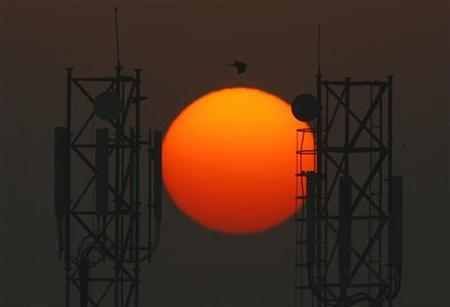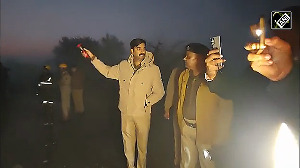Though Indians were no strangers to scams, spectrum loss was beyond their wildest imagination, says Bhupesh Bhandari.
 A news item tucked away in the inside pages of a newspaper announced that R P Singh, a former officer of the Indian Audit & Accounts Service, died on Monday after battling cancer for some months.
A news item tucked away in the inside pages of a newspaper announced that R P Singh, a former officer of the Indian Audit & Accounts Service, died on Monday after battling cancer for some months.
Singh had retired in 2011 and was the man who had punched holes in the famous 2010 report of the comptroller and auditor general, or CAG, that said the allocation of spectrum by the department of telecommunication, or DoT, then under Andimuthu Raja of the Dravida Munnetra Kazhagam, at Rs 1,651 crore (Rs 16.51 billion) for a pan-India licence had caused the government a loss of up to Rs 1.76 lakh crore.
Though Indians were no strangers to scams, this was beyond their wildest imagination. (The spectrum scam would soon be overtaken by the coal-block allocation scam in which, the CAG calculated, the government had handed out benefits of Rs 1.85 lakh crore to miners.)
The Bofors kickbacks, which had brought down the Rajiv Gandhi government in 1989, looked puny in comparison. The public outrage that followed saw leaders and businessmen alike being sent to prison.
The United Progressive Alliance government, led by Manmohan Singh, lost all credibility. The scam played no small role in the ouster of his government in 2014.
The CAG, in its report, which was presented to Parliament on November 10, 2010, calculated the presumptive loss from the sale of 2G spectrum using different methods.
Swan Telecom, one of the new licencees, had sold an equity stake to Etisalat of the United Arab Emirates; if that was used as a benchmark, the loss came to Rs 57,666 crore (Rs 576.66 billion).
S Tel, a company owned by serial entrepreneur C Sivasankaran, had in November 2007 written to the then prime minister, Manmohan Singh, that it would pay the government a revenue share of Rs 6,000 crore (Rs 60 billion) over 10 years for a pan-India licence. It raised the offer to Rs 13,752 crore (Rs 137.52 billion) a month later.
If this was used as the yardstick, the CAG said, the loss became Rs 67,364 crore (Rs 673.64 billion). In 2010-11, the government had amassed Rs 1.05 lakh crore from the sale of 3G spectrum through an auction.
Relying on the observation made by the Telecom Regulatory Authority of India, or Trai, that 2G spectrum was really 2.75G spectrum and, thus, not very different from 3G spectrum, the CAG said this inflated the loss to Rs 1,76,645 crore (Rs 1.76 trillion).
In the second half of 2011, it transpired that there wasn't complete agreement in the CAG team over the methods used to calculate the loss.
This gave the Congress shouting brigade the handle to allege that the loss estimates were politically motivated. The facts tumbled out soon thereafter.
A three-member team had done an audit of the DoT and sent its draft report to R P Singh on April 20, 2010, who was at that time director general of audit (posts and telegraph).
Vinod Rai, then CAG, mentioned in his book published earlier this year, Not Just An Accountant, that this report carried a loss figure of Rs 48,374 crore (Rs 483.74 billion).
In the report he forwarded to the headquarters, Singh said that indexed to inflation, the loss was of the order of Rs 2,645 crore (Rs 26.45 billion). He mentioned the loss based on the S Tel formula but did not include it in the draft report because the company had withdrawn the offer.
The 3G benchmark could not be used, Singh said, because "charging (money) for 2G spectrum was never recommended by TRAI, and the government has never contemplated any charge for spectrum other than the entry fee".
Mr Rai, in his book, made a few interesting observations. The S Tel offer was made in November 2007, well before the licences were issued. After the government didn't pay heed to it, S Tel moved the Delhi High Court.
And when it didn't get a favourable response there, the company took the matter to the Supreme Court. This made its offer a valid benchmark, according to Mr Rai. S Tel withdrew the offer only in March 2010 - two years after the licences were issued.
Singh's audit, Mr Rai said, was incomplete because he had only seen the DoT files and was not privy to the advice of the ministries of finance and law, and the Prime Minister's Office.
The report was updated with these inputs and Singh himself forwarded the draft report to the telecommunications secretary on July 19, 2007.
"Singh certainly did not express reservations in the content of the report that he was transmitting to the DoT," Mr Rai said in his book. The final report was sent by Singh to the headquarters on September 28, 2010, without any objection, protest or dissent. It was accepted.
That wasn't the end of the matter. In November 2012, Singh told The Indian Express that the CAG report wasn't his report. Then why did he play along? "What can I do as a subordinate when the CAG has issued written instructions on how he wants the report," he said.
Singh said that in July 2010, he was sent a "heavily-revised" report and asked to issue it to the ministry of finance and the department of telecommunication.
"There was little I could do," he said. Singh may be dead but the debate on the loss drags on.





.jpg)





